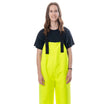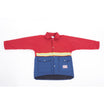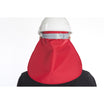Importance of Safety in Construction Sites
The hustle and bustle of a construction site often overshadow the critical aspect of safety. As the masons lay bricks, electricians ensure the wiring is right, and carpenters perfect the joinery, there's always an inherent risk lurking around every corner. Safety in construction sites is not just a regulatory requirement; it's a fundamental component that shapes the sector's attitude and practices.
Common Safety Hazards
At the heart of construction safety lies a multitude of risks that industries must navigate effectively. Several common safety hazards stand out:
- Falls: Apart from being the leading cause of death in construction, falls can lead to significant injuries. They usually occur due to unprotected edges, floor holes and unstable working surfaces.
- Struck by Objects: This refers to injuries or fatalities resulting from falling or flying objects at a job site. Unsafe usage of heavy equipment or inadequate protective measures can exacerbate this risk.
- Electrocutions: Exposed wires, improper grounding, and contact with power lines are all common sources of electrocution risks at construction sites.
Understanding these hazards is the first step towards creating safer construction sites.
Role of Proper Gear
One cannot underestimate the role of proper gear in mitigating safety hazards at construction sites. They act as the first line of defense against injuries and potential fatalities. These gears often referred to as Personal Protective Equipment (PPE), range from hard hats to steel-toe boots, safety glasses, and high-visibility clothing.
A hard hat, for instance, protects against falling objects, while safety glasses safeguard the eyes from dust and debris. Similarly, a well-fitted high-visibility vest ensures that workers are easily noticeable, reducing the chances of disastrous accidents.
Additionally, wearing the right kind of footwear – notably, steel-toe boots – is equally vital. These boots protect the wearer from injuries due to heavy falling objects and piercing through the sole.
Ensuring safety at construction sites might feel like a daunting task, but it's essentially about creating a safe working environment, taking preventive measures, and maintaining vigilance at all times. It's about protecting workers' lives and health and enhancing productivity. After all, a safe construction site is a productive one!
The Challenge: Rain and Construction Sites
As wheels grind against gravels and hammers meet nails at a bustling construction site, the weather can play a deciding role in the smooth navigation of tasks. Amongst all weather interruptions, rain can be especially challenging for construction projects. From slippery surfaces and decreased visibility to health risks for construction workers, inclement weather conditions pose a distinctive impediment. Let’s sink into the muddy challenges that rain drizzle or downpour introduces to construction sites.
Slippery Surfaces
Rain transforms steady grounds into a slippery mud bath, an arena fraught with risks of falls and accidents. Surfaces that seem harmless — like rooftops, scaffolds, or ramps — all become risky zones. A deluge can even lead to holes in the ground not easily visible, causing machinery to get stuck or worse, trapping unsuspecting workers.
- Prevention, first and foremost, could take shape as rainproof covers over key operational areas.
- Equipment, such as anti-slip mats and footwear, can also be indispensable in ensuring worker safety and maintaining efficiency during heavy rainfall.
- Timely training regarding safety measures under rainy conditions is equally important to mitigate risks associated with sudden weather changes.
Decreased Visibility
The lash of rain droplets not only blurs vision but also dampens the sound surrounding a construction site. The loss of two key senses affects coordination and communication amongst the crew, amplifying the risks of accidents.
- Rain gears like waterproof jackets and trousers can offer a first level of protection.
- Highly visible clothing and equipment, or the use of bright paint, can help offset visibility issues and enhance communication.
- Fog proof glasses also improve vision under the rain and significantly reduce the risk of accidents due to poor visibility.
Risk of Illness
It would be an oversight not to mention the increased risk of illness that construction workers face when exposed to the rain for prolonged periods. From the common cold to more serious conditions such as hypothermia or pneumonia, their health risks are significantly elevated.
- Ensuring a warm and dry place for work breaks and change of clothes is a simple, yet effective preventative measure.
- Basic health measures, like offering flu vaccines to workers, can also be a crucial step in protecting their health during the rainy season.
Offering solutions to these challenges goes beyond just the economics of keeping a construction project on schedule. It is a crucial part of ensuring the safety and health of a team that works tirelessly to shape our surroundings. Weathering the rain at a construction site is a challenge but with careful planning, appropriate resources, and a worker-first approach, it’s not insurmountable.
Old Rain Gear Limitations in Construction Sites
We're all familiar with this scenario; dark clouds start closing in on your construction site, and you whip out your handy rain gear, fully expecting it to shield you against the torrential downpour. In theory, this sounds perfect. However, when put to the test, traditional rain gears may actually exhibit certain limitations that could potentially interfere with your work performance. Let's delve into some of these limitations.
Limited Waterproofing
The primary function of any rain gear should be its ability to remain waterproof. Unfortunately, not all rain gear lives up to this task. More often than not, old rain gear materials like rubber, PVC, or nylon, fail to provide complete water resistance. Beyond general discomfort, this lack of waterproofing can disrupt your workflow, potentially causing a slowdown in work or, at worst, a complete halt.
Poor Visibility
Rain and mist can naturally obscure your vision, and an ill-designed rain gear can exacerbate this issue. Older models of rain gear lack other visibility enhancements such as reflective tapes or bright color schemes, rendering the wearer almost invisible in low-light conditions. This can pose severe safety risks, especially in busy construction sites where visibility is key in preventing accidents.
Poor Insulation
Rain typically comes with a drop in temperature. Nothing is more miserable than being cold and wet while trying to concentrate on the job at hand. Old rain gear often overlooks the critical aspect of insulation, focusing more on the waterproofing element. Thus, users are often left feeling cold and uncomfortable, which can have a negative impact on productivity.
Limited Mobility
Finally, mobility is an integral element in the construction scene. The need to climb, lift, and shift has to go unhindered, rain or shine. However, many older rain gear designs fail to accommodate this need for flexibility, owing to their rigid and heavy materials. This lack of maneuverability can significantly hamper a worker’s efficiency, causing project timelines to shift and productivity levels to drop.
Taking these limitations into account, it becomes crucial to invest in modern, high-quality rain gear that ensures full waterproofing, improved visibility, proper insulation, and better mobility. While old rain gear has served us well in the past, advancements in technology and design offer better alternatives to protect ourselves and maintain productivity on construction sites, regardless of the weather.
Improvements in Rain Gear Technology
Rain, although essential for the environment, can sometimes be a hindrance to our daily activities. Thanks to the advancements in modern technology, rain gear manufacturers have managed to manufacture rain gear products that ensure our day-to-day lives remain uninterrupted, come rain or shine! This article highlights the innovative improvements in rain gear technology such as advanced waterproofing, enhanced visibility features, improved warmth and insulation, and increased mobility and flexibility.
Advanced Waterproofing
The difference between a good piece of rain gear and a great one often lies in its ability to keep you dry. With the advent of modern materials and manufacturing techniques, today’s rain gear offer advanced waterproofing features. Manufacturers are employing techniques such as utilizing hydrophobic coatings, seam sealing and the development of new materials like modern polyurethane, which improves the water repellency of rain gear. These advanced waterproofing techniques ensure you stay dry and comfortable even during the heaviest downpour.
Enhanced Visibility Features
Safety, especially during a downpour, is a concern for many. Hence, rain gear manufacturers have given a significant emphasis to visibility features in new products. These products now come with reflective strips, neon colors, and inbuilt LED lights, ensuring improved visibility in low light or foggy conditions. Hence, whether you're out for an evening jog, cycling, or merely walking home, you can rest assured, knowing that your rain gear is keeping you visible.
Improved Warmth and Insulation
Keeping dry is one part of the equation when it comes to rain gear, but ensuring warmth is equally crucial, especially in colder climates. Modern rain gear, with improved warmth and insulation attributes, is designed to keep you warm and cozy. The integration of lightweight insulation materials and thermal linings maintain your body temperature without adding extra bulk. This feature means you can comfortably wear your rain gear for extended periods, even when temperatures drop.
Increased Mobility and Flexibility
Finally, one cannot underestimate the importance of comfort and mobility in rain gear. In response to customer needs, manufacturers have greatly improved the mobility and flexibility of rain gear. Features such as articulated joint areas, adjustable cuffs and hoods, and the introduction of stretchable water-resistant fabrics have greatly increased the comfort and wearability of rain gear. These technologies offer users a full range of motion during use.
Rain gear technology has continued to evolve and improve, enhancing the user's experience during inclement weather. These developments in waterproofing, visibility, warmth, and mobility make rain gear more effective and comfortable, allowing you to carry on with your daily activities regardless of the weather conditions. So next time you're shopping for rain gear, keep an eye out for these advanced features!
Revolutionizing Safety with Improved Rain Gear
At first glance, rain gear may not appear to be an essential component of working safety. However, when it comes to industries that expose their employees to harsh weather conditions, high-quality rain gear is a game-changer. In this section, we're going to delve deeper into how improved rain gear can revolutionize safety measures, decrease the rate of accidents, enhance worker comfort, and ultimately lead to higher productivity.
Reducing Incident Rates
Sudden, unexpected slips and falls — they're a prevalent concern in industries like construction or outdoor event management. Such accidents usually spike during adverse weather conditions. By adopting improved, all-weather rain gear, companies have reported significant reductions in these types of incidents.
- Sturdier, non-slip footwear, part of the new generation rain gear, significantly reduces the risk of slipping incidents.
- High-visibility jackets and other clothing items ensure that workers remain visible even under heavy rain or fog.
- Waterproof gloves provide a firm grip, reducing the chances of dropping tools or mishandling equipment.
Improving Worker Comfort
One of the most apparent benefits of high-quality rain gear is the improved comfort for the workers. After all, comfort is intrinsically tied to safety. Dry and comfortable workers are less likely to commit errors out of exhaustion or distraction.
- Advanced rain gear materials are breathable, reducing the risk of overheating and thus keeping the workers comfortable over a long period.
- The adoption of lightweight materials helps to alleviate the stress on workers' bodies, allowing them to maneuver more easily.
- Innovations like adjustable cuffs, reinforced seams, and removable layers offer adaptability to various weather conditions and job requirements.
Improving Productivity
Finally, let's not forget about the profound impact of safety and comfort on productivity. A safer environment coupled with improved physical comfort motivates employees, reduces time lost due to injuries, and increases overall efficiency.
- By reducing accidents and ensuring worker comfort, improved rain gear helps to minimize downtime, leading to better resource optimization.
- Workers feel valued when their employers invest in their safety, which directly improves morale and work ethic.
- With proper rain gear, tasks can continue seamlessly even in bad weather conditions, ensuring that deadlines are met and clients are satisfied.
Indeed, the importance of quality, reliable rain gear goes beyond mere comfort. It serves as a lifeline in challenging environments, reducing incidents, providing comfort, and driving productivity. The implications for worker safety and business productivity echo the need for such protective measures to be universally adopted across all relevant industries.
Conclusion
The delicate balance between safety and productivity on construction sites has always been a challenge - a challenge further complicated by inclement weather conditions. The advances in rain gear technology, however, have brought about a significant transformation. By mitigating site accidents, enhancing worker comfort, and bolstering overall productivity, the improved rain gear technology certainly paints a promising picture.
Companies like Hurricane Raingear are leading this revolution, providing rain gear that combines 100% waterproofing, breathability, and unrestricted movement. The use of reflective 3M striping for increased visibility is yet another testament to their dedication to safety. Handcrafted in the Pacific North West, their products exemplify quality craft and a commitment to customer satisfaction. If you wish to further explore their range of products, feel free to visit their website here.
In essence, the evolution of rain gear is a shining example of how technology can revolutionize safety and productivity on construction sites. It is an affirmation that, even against challenging weather conditions, work can continue without compromising the well-being and comfort of those who bring our built environments to life. Harnessing these improvements, we keep stepping closer to safer and more efficient construction sites every day, and indeed, a better tomorrow.
Frequently Asked Questions
-
What are the key features to look for in improved rain gear for construction sites?
Key features to look for in improved rain gear for construction sites include waterproof and breathable material, high-visibility colors, reflective tape for visibility, durable construction, adjustable cuffs and hoods, multiple pockets for storage, and reinforced knees and elbows.
-
How does improved rain gear enhance safety on construction sites?
Improved rain gear enhances safety on construction sites by keeping workers dry and comfortable, reducing the risk of hypothermia and other weather-related illnesses, improving visibility in low-light conditions, preventing accidents caused by reduced grip due to wet clothing, and protecting against injuries from sharp objects.
-
Are there specific regulations or standards for rain gear in the construction industry?
Yes, there are specific regulations and standards for rain gear in the construction industry. For example, the Occupational Safety and Health Administration (OSHA) in the United States has regulations regarding the use of high-visibility clothing and protective gear in construction sites.
-
Can improved rain gear be customized with company logos or branding?
Yes, many manufacturers offer the option to customize rain gear with company logos or branding. This can help promote brand visibility and create a sense of professionalism among construction workers.
-
How do I choose the right size of improved rain gear?
To choose the right size of improved rain gear, refer to the manufacturer's size chart and take accurate measurements of chest, waist, and inseam. It's important to ensure a proper fit to maintain comfort and freedom of movement while working on construction sites.





















Leave a comment
This site is protected by hCaptcha and the hCaptcha Privacy Policy and Terms of Service apply.